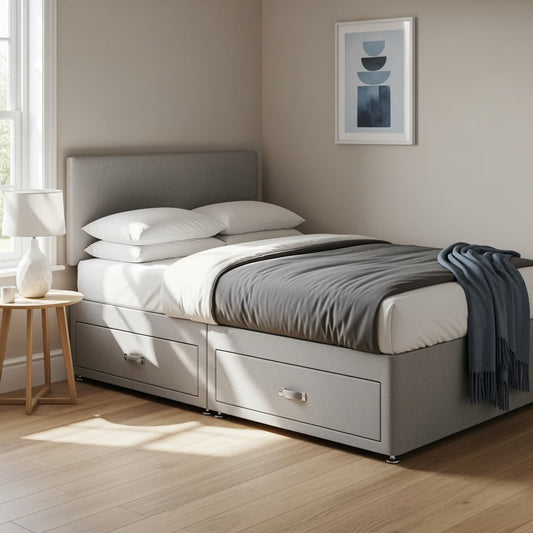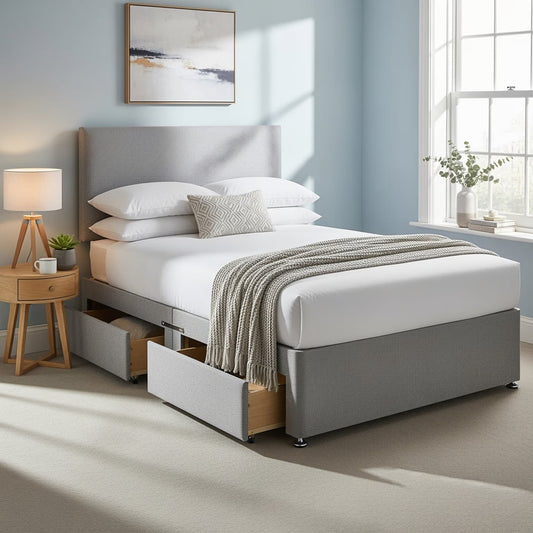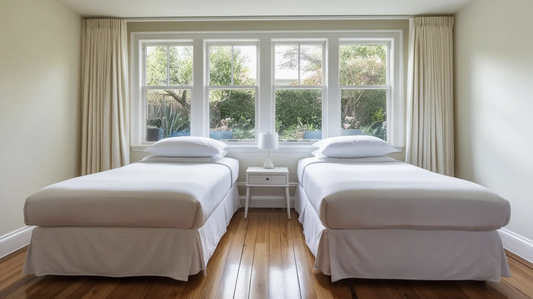Are Divan Beds Stronger Than Slats?
Are divan beds stronger than slatted beds? In most cases, yes. Divan beds, with their solid platform, offer unbeatable support and durability, making them the stronger option for the majority of sleepers. They’re less likely to give way under pressure and provide a reliable foundation for years to come. That said, slatted beds hold their own with benefits like ventilation and flexibility, which might tip the scales for some.
What Are Divan Beds and Slatted Beds?
Before we dive into comparing their strength, let’s define what divan beds and slatted beds are and why they’re so popular in the UK.
Divan Beds
Divan beds are a common sight in British bedrooms, valued for their practicality and sturdy design. They feature a base made from a wooden frame, often upholstered in fabric, with a solid platform top that provides a flat, even surface for your mattress. One of their standout features is the option for built-in storage, such as drawers or an ottoman lift, making them a brilliant choice for smaller homes where space is tight.
Slatted Beds
Slatted beds, by contrast, have a base made up of horizontal wooden or metal slats that span the width of the bed frame. These slats are spaced apart to support the mattress while allowing air to circulate beneath it. Slatted beds are often chosen for their ventilation benefits and the subtle flexibility they offer, which can enhance comfort for some sleepers.
Key Features and Benefits
Both divan beds and slatted beds bring distinct advantages to the table, but their differences in construction have a big impact on their strength.
Divan Beds: Built for Strength
- Robust Support: The solid platform of a divan bed distributes weight evenly across the base, reducing strain on the mattress and preventing sagging. This makes them exceptionally strong and reliable.
- Storage Solutions: Many divan beds come with practical storage options. For example, divan bed bases with storage combine strength with functionality, offering drawers or ottoman space without compromising the bed’s stability.
- Longevity: With no moving parts to wear out, divan beds are built to last, requiring minimal maintenance over the years.
Slatted Beds: Flexibility Meets Ventilation
- Airflow: The gaps between the slats promote ventilation, keeping your mattress fresh and reducing the risk of dampness or mould - handy in the UK’s often humid climate.
- Responsive Feel: The slight flexibility of the slats can adapt to your body’s movements, offering a softer, more tailored support that some find more comfortable.
- Style Points: Slatted beds often have a classic or rustic charm, appealing to those who want their bed to double as a design statement.
Addressing Common Concerns
Strength is a top priority when choosing a bed base, and both options come with questions that need answering. Let’s tackle some of the most common concerns.
Are Slatted Beds Less Durable?
A frequent worry with slatted beds is that the slats might not hold up over time. If the slats are poorly made or spaced too widely, they can bend or snap, especially under heavier weights. This can lead to uneven mattress support and a shorter lifespan for the bed. High-quality slatted beds with thicker, well-spaced slats can reduce this risk, but it’s still a potential weak point compared to a solid base.
Can Divan Beds Support Heavy Weights?
Some wonder if divan beds can handle substantial loads without buckling. The good news is that most divan beds are designed with strength in mind, typically supporting 80-100kg per person as standard. For extra peace of mind, reinforced models are available for heavier sleepers. The solid platform ensures weight is spread evenly, making divan beds a dependable choice.
Does Ventilation Compromise Strength?
Ventilation is another hot topic. Slatted beds excel here, with their open design allowing air to flow freely beneath the mattress. Divan beds, with their solid base, don’t offer the same breathability, which could be a concern for some. However, many modern mattresses are designed with breathable materials, offsetting this issue. When it comes to strength, the solid structure of a divan bed generally outshines the slatted alternative.
Tips for Choosing the Right Bed Base
Deciding between a divan bed and a slatted bed isn’t just about strength - it’s about what suits your lifestyle. Here are some practical tips to guide your choice:
- Your Weight: If you or your partner are on the heavier side, a divan bed’s solid support makes it a safer bet. It’s less likely to strain under pressure.
- Sleep Comfort: Do you wake up feeling hot? A slatted bed’s airflow might be a game-changer. If stability matters more, stick with a divan.
- Space Needs: Short on room? Divan bed bases with storage offer a strong foundation plus clever storage solutions - perfect for cluttered UK flats.
- Budget: Slatted beds can be cheaper upfront, but divan beds often prove more cost-effective over time thanks to their durability and added features.
Conclusion: So, Which Is Stronger?
Are divan beds stronger than slatted beds? In most cases, yes. Divan beds, with their solid platform, offer unbeatable support and durability, making them the stronger option for the majority of sleepers. They’re less likely to give way under pressure and provide a reliable foundation for years to come. That said, slatted beds hold their own with benefits like ventilation and flexibility, which might tip the scales for some.
Still torn? Dive deeper into the debate with our guide: Is a Divan Better Than a Slatted Bed?. It’s packed with insights to help you decide.
What’s your take? Have you tried both divan and slatted beds? Share your thoughts in the comments - we’d love to hear what works for you!





